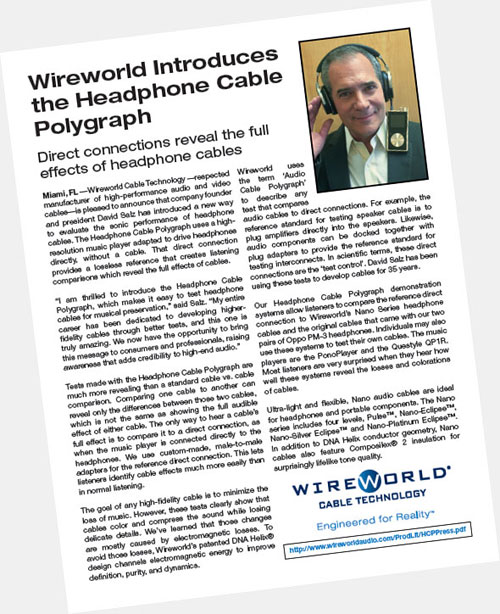Dare to Compare: Wireworld's Headphone Cable Polygraph
It's easiest to call Salz a cable objectivist. He's not interested in creating cables whose performance is editorial in any way, leaning in one sonic direction or another. In fact, he's not interested in creating cables with any definable sound. Instead, his goal is more simple and direct: to design and manufacture cables that are closest to no cables at all. His method is straightforward and demonstrable: he follows a strict design process based on his patented DNA Helix geometry, then tests the final product with his own ears. One of the tools he uses is Wireworld's Headphone Cable Polygraph, which sounds grandiose but is actually utilitarian. Salz has connected a portable music player -- a Pono Player or Questyle QP1R -- directly to a pair of headphones, without a cable in between. This is done with a specially made male-to-male connector that has complete metal-to-metal contact. You can see the final product in the picture above (Salz models it himself). The entire thing looks feasible as a product until you try it on and feel the player bumping against your shoulder like a gigantic earring. The Polygraph begins with listening to the music player connected directly to the headphones and proceeds through a series of headphone cables, including the one that came with the headphones, Oppo PM-3s in my case. I listened to the direct connection, then the Oppo cable, and I was unprepared for the difference. With the direct connection, the headphones sounded like high-resolution devices, unveiling every nuance of the recording in proportion, putting it all instantly there. In great contrast, with the stock cable, tonality was opaque, transients blunted, dynamics compressed and bass indistinct. I could be more frank: there was nothing with Oppo's own cable that was close to the sound of direct connection. Next was a cable from Wireworld, the Pulse, which I had been using at home with Sennheiser HD 600s and HD 650s. Again the difference was enormous, but all to the better, the sound restored to much of what made direct connection so compelling. Just to test my impressions, I immediately plugged in the Oppo cable and once again the center did not hold -- the illusion collapsed. I then skipped over a couple of cables in the bundle to Wireworld's top-of-the-line Nano-Platinum Eclipse ($450/meter length). The sound was broadly like that of the Pulse but more detailed, especially in the uppermost treble and throughout the midrange, and more airy, the sense that the performers were pushing the spatial boundaries of the headphones being obvious. Singers were more palpable, their voices more direct, underscoring what's so significant about headphone listening to begin with -- you're closer to the recording and the recorded event -- not to mention being a step closer to direct connection and Salz's no-cable-at-all goal. Back to the Pulse and Nano-Eclipse that I received before CES. I had been using them for weeks, the Pulse, as I've mentioned, with Sennheiser HD 600s and HD 650s, which have the same connectors, and the Nano-Eclipse with Sennheiser HD 800s, which I'd call the top of the line, except that they've been recently replaced by the HD 800 S. What I heard with both cables underscored the need for manufacturers like Wireworld to create headphone cables to begin with. The Pulse and Nano-Eclipse improved on the stock cables in obvious fashion, both in terms of sound and physical configuration -- the Wireworld cables were better constructed and didn't cause noise through the headphones with the slightest movement. All of the Sennheiser 'phones simply sounded more like themselves with the Wireworld cables, which further affirmed my belief that Sennheiser makes the best headphones here and now (even while hobbling them with sub-par cables). In a blog I wrote a while back, I made the point that HDMI cables are probably the most maligned and misunderstood of all A/V cables. Right after them come headphone cables. What ties both together is not what we audiophiles know, but rather what non-audiophiles think: that cables can't possibly make a difference, because they're "just wires." Besides, HDMI signals are digital -- ones and zeros -- so how can a cable possibly affect them? As for headphones, the dodge is more general: I don't hear anything, so nothing exists. As I've stated in reviews many times, perception isn't a
constant. Some of us have greater perceptive abilities than others, and it's a fallacy to
believe that what you don't hear someone else couldn't possibly hear. But don't take that
from me. Read what David Salz has to say and then take his Headphone Cable Polygraph, or
just compare a Wireworld headphone cable to the one that came with your 'phones. I can't
imagine you won't hear what I heard. |

 efore leaving for CES at the
beginning of January, I had nearly finished a blog on two Wireworld headphone cables: the
Pulse ($138/meter length) and Nano-Eclipse ($225/meter length). But then I sat down and
talked with David Salz, head of Wireworld, during the show, and that discussion changed
everything.
efore leaving for CES at the
beginning of January, I had nearly finished a blog on two Wireworld headphone cables: the
Pulse ($138/meter length) and Nano-Eclipse ($225/meter length). But then I sat down and
talked with David Salz, head of Wireworld, during the show, and that discussion changed
everything.